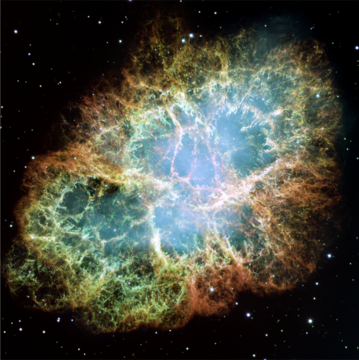Stars take the idea of a “last hurrah” to beautifully explosive level. When a star runs out of energy and collapses, it will condense into a bundle of energy and explode. Supernovas are by far the largest explosion in the universe and can only occur to a star that is truly massive. Supernovas normally occur extremely far away, as not many of the stars close to us are capable of this massive discharge. The closest supernova in years, Supernova 1987A, was still an astonishing 168,000 light years away! However, it isn’t such a bad thing that these supernovas are occurring hundreds of thousands of light years away. For example, a supernova thirty light years away would completely destroy the ozone layer and eradicate all ocean life. In addition, the conditions may cause the nitrogen and oxygen in our atmosphere to combine into the poisonous nitrous oxide. A safe distance for a supernova explosion is at least 100 light years away from us. While these radiant membranes of light may looks spectacular, they can be just as easily destructive.
- Comment
- Reblog
-
Subscribe
Subscribed
Already have a WordPress.com account? Log in now.

I thought this writing on Supernovas was very interesting to read. I thought it was cool to see the true power they have once they explode, it is crazy to think that the Supernova is so powerful that even if it was 30 light years away it could still destroy our planet when it explodes. It is also interesting that scientists are able to classify this type of star with such certainty when it is so far away, how do the scientists know that this only happens when the stars are low on energy and collapses?
LikeLike
Bryan, thank you for sharing! This is really interesting. I also remember reading that if Alpha Centauri (the closest star other than the Sun at only about 4.4 light years from Earth) were to reach supernova, it would trigger the extinction of most life and even change the air on Earth. If Betelgeuse reached supernova, it would eventually become brighter than 10 billion Suns and appear to be even brighter than the Full Moon here on Earth (Forbes). Betelgeuse actually could reach supernova during our lives. It also may have already reached that point or it could be 100,000 years until it reaches supernova. Do you guys think we will have an escape plan to another planet by the time a catastrophic event threatens Earth?
LikeLike
This was really interesting to read! Although we have learned about supernovas, why the occur and when the occur, I had not fully comprehended their impact. Knowing that there are many stars within the 100 light year radius, it is shocking to know that the explosion of those stars would be so devastating to earth. Luckily, as you said, not many of these closer stars would be capable of this, yet still I would hope that we are aware of any possibilities of such catastrophic events. To answer @brandonlipper’s question, I would hope that we would be able to have an escape plan in place by this time, yet I would imagine it would be unlikely. It would take more than just moving to another planet to avoid this destruction, as it can wreak havoc at 100 light years away.
LikeLike
I always thought supernovas were the coolest thing in the universe. I mean they just look awesome, but boy am I glad we get to admire them afar. When you see a still photo of a supernova, it easy to just be in awe of all the colors and patterns. I don’t know about other people but it makes me picture the actual supernova event as frozen and stuck in place, not realizing that it’s a literal explosion hurling rocks and space dust at unimaginable speeds. Now that I think about it, after learning about universality–which states that the laws of physics are the same everywhere in the universe allowing us to apply what we observe on earth to the vast galaxy– other naturalistic principles of the Earth are also reflected in the universe. Like the fact that with animals, plants, and other life, the most colorful and beautiful looking are the most deadly and dangerous. Supernovas are a perfect example of the universe’s most beautiful events can be the most catastrophic.
LikeLike
Supernovas are very energetic explosions, yes! But there are many other things in the universe that are equally or greater in energy. For example, quasars! Nevertheless, the amount of energy a Supernova emits with it’s explosion depends on the type of supernova that occurs. You have thermonuclear supernovas and core collapse. Thermonuclear ones are used as standard candles to measure the expansion of the universe and occurs when a star reaches a mass close to the Chandrasekhar limit (mass ~2.3 solar masses). On the other hand, core collapse supernova occur with very massive stars and typically lead to a black hole; These are even more energetic! Great Post!!!
LikeLike